Review of Fiber-Reinforced Composite Structures with Multifunctional Capabilities through Smart Textiles
Abstract
1. Introduction
2. Multifunctional Composites
2.1. Principles and Interests
2.2. Material Modifications and Combinations
2.3. Manufacturing Multifunctional Composites
2.3.1. Modifying Textiles
2.3.2. Traditional Manufacturing
2.3.3. Additive Manufacturing and Emerging Capabilities
2.3.4. Spinning Techniques
3. Capabilities and Applications
3.1. Structural Health Monitoring (SHM)
3.2. Power Conduction
3.3. Power Transfer and Wireless Communications
3.3.1. Power Transfer and Wireless Charging
3.3.2. Wireless Data Transmission
3.4. Power Storage
3.4.1. Embedded Systems
3.4.2. Structural Supercapacitors
3.4.3. Laminated Structural Batteries
3.4.4. Multifunctional Energy Storage Devices
3.5. Energy Harvesting
3.6. Data Transfer
3.7. Additional Multifunctionalities
4. Design Challenges
4.1. Material Compatibility and Integration
4.2. Challenges with Fabrication Techniques
4.3. Performance Optimization and Testing
4.4. Modeling and Simulation
4.4.1. Developing Geometries for Simulation
4.4.2. Textile Multiscale Modeling Techniques
4.4.3. Integrating Multiphysics Responses
4.4.4. Application of Deep Neural Networks for Design Optimization
5. Future Directions
6. Concluding Remarks
Author Contributions
Funding
Data Availability Statement
Acknowledgments
Conflicts of Interest
References
- Barbero, E.J. Introduction to Composite Materials Design, 3rd ed.; CRC Press: Boca Raton, FL, USA, 2017. [Google Scholar] [CrossRef]
- Adumitroaie, A.; Barbero, E.J. Stiffness and Strength Prediction for Plain Weave Textile Reinforced Composites. Mech. Adv. Mater. Struct. 2012, 19, 169–183. [Google Scholar] [CrossRef]
- Matos, H.; Ngwa, A.N.; Chaudhary, B.; Shukla, A. Review of Implosion Design Considerations for Underwater Composite Pressure Vessels. J. Mar. Sci. Eng. 2024, 12, 1468. [Google Scholar] [CrossRef]
- Berthelot, J.-M.; Ling, F.F. Composite Materials: Mechanical Behavior and Structural Analysis; Springer: Berlin/Heidelberg, Germany, 1999; Volume 435. [Google Scholar]
- Barnett, D.M.; Rawal, S.; Rummel, K. Multifunctional Structures for Advanced Spacecraft. J. Spacecr. Rocket. 2001, 38, 226–230. [Google Scholar] [CrossRef]
- Chaudhary, B.; Matos, H.; Das, S.; Owens, J. Multifunctional composite structures with embedded conductive yarns for shock load monitoring and failure detection. Smart Mater. Struct. 2024, 33, 037001. [Google Scholar] [CrossRef]
- Güemes, A.; Fernandez-Lopez, A.; Pozo, A.R.; Sierra-Pérez, J. Structural Health Monitoring for Advanced Composite Structures: A Review. J. Compos. Sci. 2020, 4, 13. [Google Scholar] [CrossRef]
- Güemes, A.; Fernández-López, A.; Díaz-Maroto, P.F.; Lozano, A.; Sierra-Perez, J. Structural Health Monitoring in Composite Structures by Fiber-Optic Sensors. Sensors 2018, 18, 1094. [Google Scholar] [CrossRef]
- Alokita, S.; Rahul, V.; Jayakrishna, K.; Kar, V.R.; Rajesh, M.; Thirumalini, S.; Manikandan, M. 4—Recent advances and trends in structural health monitoring. In Structural Health Monitoring of Biocomposites, Fibre-Reinforced Composites and Hybrid Composites; Jawaid, M., Thariq, M., Saba, N., Eds.; Woodhead Publishing: Sawston, UK, 2019; pp. 53–73. [Google Scholar] [CrossRef]
- Wu, Q.; Wang, R.; Yu, F.; Okabe, Y. Application of an Optical Fiber Sensor for Nonlinear Ultrasonic Evaluation of Fatigue Crack. IEEE Sens. J. 2019, 19, 4992–4999. [Google Scholar] [CrossRef]
- Andreades, C.; Meo, M.; Ciampa, F. Tensile and fatigue testing of impacted smart CFRP composites with embedded PZT transducers for nonlinear ultrasonic monitoring of damage evolution. Smart Mater. Struct. 2020, 29, 055034. [Google Scholar] [CrossRef]
- Multifunctional Composites Market Size, Trends, Growth 2030. Available online: https://www.fairfieldmarketresearch.com (accessed on 10 July 2024).
- Chaudhary, B.; Matos, H.; Das, S.; Owens, J. Multifunctional Carbon/Epoxy Composites with Power Transmission Capabilities. Mater. Today Commun. 2023, 35, 105665. [Google Scholar] [CrossRef]
- Chaudhary, B.; Lyngdoh, G.A.; Owens, J.; Das, S.; Matos, H. An investigation into the electromechanical performance of textile fabrics with conductive yarn elements for data transfer capabilities. Text. Res. J. 2024, 94, 2079–2091. [Google Scholar] [CrossRef]
- Lincon, M.; Chaudhary, B.; Matos, H.; Chalivendra, V.B.; Shukla, A. Failure Analysis and Piezo-resistance Response of Intralaminar Glass/Carbon Hybrid Composites Under Blast Loading Conditions. J. Eng. Mater. Technol. 2024, 147, 1–41. [Google Scholar] [CrossRef]
- Chalivendra, V. Damage sensing in natural fiber/epoxy composites. In Handbook of Epoxy/Fiber Composites; Mavinkere Rangappa, S., Parameswaranpillai, J., Siengchin, S., Thomas, S., Eds.; Springer: Singapore, 2020; pp. 1–17. [Google Scholar] [CrossRef]
- Sousa, R.; Chalivendra, V. Electro-mechanical behavior of multi-functional glass fiber composites under dynamic Mode-I fracture loading. J. Compos. Mater. 2023, 57, 4009–4023. [Google Scholar] [CrossRef]
- Gibson, R.F. A review of recent research on mechanics of multifunctional composite materials and structures. Compos. Struct. 2010, 92, 2793–2810. [Google Scholar] [CrossRef]
- Thostenson, E.T.; Chou, T.-W. Carbon Nanotube Networks: Sensing of Distributed Strain and Damage for Life Prediction and Self Healing. Adv. Mater. 2006, 18, 2837–2841. [Google Scholar] [CrossRef]
- Thostenson, E.T.; Chou, T.-W. Carbon nanotube-based health monitoring of mechanically fastened composite joints. Compos. Sci. Technol. 2008, 68, 2557–2561. [Google Scholar] [CrossRef]
- Pinto, M.; Chalivendra, V.B.; Kim, Y.K.; Lewis, A.F. Improving the strength and service life of jute/epoxy laminar composites for structural applications. Compos. Struct. 2016, 156, 333–337. [Google Scholar] [CrossRef]
- de Araujo, M.; Fangueiro, R.; Geraldes, M.J. Developing fibrous multifunctional structures for technical applications. AUTEX Res. J. 2005, 5, 49–54. [Google Scholar] [CrossRef]
- Gorgutsa, S.; Bachus, K.; LaRochelle, S.; Oleschuk, R.D.; Messaddeq, Y. Washable hydrophobic smart textiles and multi-material fibers for wireless communication. Smart Mater. Struct. 2016, 25, 115027. [Google Scholar] [CrossRef]
- Garnier, B.; Mariage, P.; Rault, F.; Cochrane, C.; Koncar, V. Electronic-components less fully textile multiple resonant combiners for body-centric near field communication. Sci. Rep. 2021, 11, 2159. [Google Scholar] [CrossRef]
- Chen, G.; Xiao, X.; Zhao, X.; Tat, T.; Bick, M.; Chen, J. Electronic Textiles for Wearable Point-of-Care Systems. Chem. Rev. 2022, 122, 3259–3291. [Google Scholar] [CrossRef]
- Phan, P.T.; Thai, M.T.; Hoang, T.T.; Davies, J.; Nguyen, C.C.; Phan, H.-P.; Lovell, N.H.; Do, T.N. Smart textiles using fluid-driven artificial muscle fibers. Sci. Rep. 2022, 12, 11067. [Google Scholar] [CrossRef] [PubMed]
- Caruso, M.M.; Blaiszik, B.J.; White, S.R.; Sottos, N.R.; Moore, J.S. Full Recovery of Fracture Toughness Using a Nontoxic Solvent-Based Self-Healing System. Adv. Funct. Mater. 2008, 18, 1898–1904. [Google Scholar] [CrossRef]
- Subbiah, D.K.; Balasubramanian, S.; Kulandaisamy, A.J.; Jayanth Babu, K.; Das, A.; Rayappan, J.B.B. Surface modification of textiles with nanomaterials for flexible electronics applications. In Advances in Functional Finishing of Textiles; Shahid, M., Adivarekar, R., Eds.; Springer: Singapore, 2020; pp. 1–42. [Google Scholar] [CrossRef]
- Hand Lay-Up—An Overview|ScienceDirect Topics. Available online: https://www.sciencedirect.com/topics/engineering/hand-lay-up (accessed on 1 July 2024).
- Avila, A.F.; Morais, D.T.S. A multiscale investigation based on variance analysis for hand lay-up composite manufacturing. Compos. Sci. Technol. 2005, 65, 827–838. [Google Scholar] [CrossRef]
- Pereira, T.; Guo, Z.; Nieh, S.; Arias, J.; Hahn, H.T. Energy Storage Structural Composites: A Review. J. Compos. Mater. 2009, 43, 549–560. [Google Scholar] [CrossRef]
- Lim, S.T.; Lee, W.I. An analysis of the three-dimensional resin-transfer mold filling process. Compos. Sci. Technol. 2000, 60, 961–975. [Google Scholar] [CrossRef]
- Tamakuwala, V.R. Manufacturing of fiber reinforced polymer by using VARTM process: A review. Mater. Today Proc. 2021, 44, 987–993. [Google Scholar] [CrossRef]
- Wanchoo, P.; Chaudhary, B.; Li, H.-W.-X.; Matos, H.; Shukla, A. Blast failure and energy analysis of rubber-modified carbon-fiber vinyl-ester composite laminates. Mech. Mater. 2023, 183, 104685. [Google Scholar] [CrossRef]
- Silveira, D.C.; Gomes, N.; Rezende, M.C.; Botelho, E.C. Electromagnetic Properties of Multifunctional Composites Based on Glass Fiber Prepreg and Ni/Carbon Fiber Veil. J. Aerosp. Technol. Manag. 2017, 9, 231–240. [Google Scholar] [CrossRef]
- Meredith, J.; Bilson, E.; Powe, R.; Collings, E.; Kirwan, K. A performance versus cost analysis of prepreg carbon fibre epoxy energy absorption structures. Compos. Struct. 2015, 124, 206–213. [Google Scholar] [CrossRef]
- Additive Manufacturing—General Principles—Fundamentals and Vocabulary. Available online: https://www.astm.org/f3177-21.html (accessed on 7 July 2024).
- Lu, Y.; Han, X.; Gleadall, A.; Chen, F.; Zhu, W.; Zhao, L. Continuous fibre reinforced Vat photopolymerisation (CONFIB-VAT). Addit. Manuf. 2022, 60, 103233. [Google Scholar] [CrossRef]
- Asif, S.; Chansoria, P.; Shirwaiker, R. Ultrasound-assisted vat photopolymerization 3D printing of preferentially organized carbon fiber reinforced polymer composites. J. Manuf. Process. 2020, 56, 1340–1343. [Google Scholar] [CrossRef]
- Khatua, V.; Gurumoorthy, B.; Ananthasuresh, G.K. A vat photopolymerization process for structures reinforced with spatially steered flexible fibers. Addit. Manuf. 2024, 86, 104183. [Google Scholar] [CrossRef]
- Zindani, D.; Kumar, K. An insight into additive manufacturing of fiber reinforced polymer composite. Int. J. Lightweight Mater. Manuf. 2019, 2, 267–278. [Google Scholar] [CrossRef]
- Tee, Y.L.; Tran, P.; Leary, M.; Pille, P.; Brandt, M. 3D Printing of polymer composites with material jetting: Mechanical and fractographic analysis. Addit. Manuf. 2020, 36, 101558. [Google Scholar] [CrossRef]
- Gülcan, O.; Günaydın, K.; Tamer, A. The State of the Art of Material Jetting—A Critical Review. Polymers 2021, 13, 2829. [Google Scholar] [CrossRef]
- Enrique, P.D.; Marzbanrad, E.; Mahmoodkhani, Y.; Keshavarzkermani, A.; Al Momani, H.; Toyserkani, E.; Zhou, N.Y. Design of binder jet additive manufactured co-continuous ceramic-reinforced metal matrix composites. J. Mater. Sci. Technol. 2020, 49, 81–90. [Google Scholar] [CrossRef]
- Shakor, P.; Chu, S.H.; Puzatova, A.; Dini, E. Review of binder jetting 3D printing in the construction industry. Prog. Addit. Manuf. 2022, 7, 643–669. [Google Scholar] [CrossRef]
- Chaudhary, B.; Li, H.; Matos, H. Long-term mechanical performance of 3D printed thermoplastics in seawater environments. Results Mater. 2023, 17, 100381. [Google Scholar] [CrossRef]
- Brounstein, Z.; Talley, S.; Dumont, J.H.; Zhao, J.; Lee, K.-S.; Labouriau, A. Fused filament fabrication of polymer composites for extreme environments. J. Mater. Res. 2020, 35, 1493–1503. [Google Scholar] [CrossRef]
- Ghimire, R.; Liou, F. Quasi-Static Multifunctional Characterization of 3D-Printed Carbon Fiber Composites for Compressive-Electrical Properties. Polymers 2022, 14, 328. [Google Scholar] [CrossRef]
- Glogowsky, A.; Korger, M.; Rabe, M. Influence of print settings on conductivity of 3D printed elastomers with carbon-based fillers. Prog. Addit. Manuf. 2024, 9, 791–803. [Google Scholar] [CrossRef]
- Riddervold, A.; Nesheim, O.S.; Eikevåg, S.W.; Steinert, M. Electrical Resistance Response to Strain in 3D-Printed Conductive Thermoplastic Polyurethane (TPU). Appl. Sci. 2024, 14, 3681. [Google Scholar] [CrossRef]
- Ferreira, I.; Machado, M.; Alves, F.; Torres Marques, A. A review on fibre reinforced composite printing via FFF. Rapid Prototyp. J. 2019, 25, 972–988. [Google Scholar] [CrossRef]
- Karimi, A.; Rahmatabadi, D.; Baghani, M. Various FDM Mechanisms Used in the Fabrication of Continuous-Fiber Reinforced Composites: A Review. Polymers 2024, 16, 831. [Google Scholar] [CrossRef]
- Goh, G.D.; Yap, Y.L.; Agarwala, S.; Yeong, W.Y. Recent Progress in Additive Manufacturing of Fiber Reinforced Polymer Composite. Adv. Mater. Technol. 2019, 4, 1800271. [Google Scholar] [CrossRef]
- Hou, Y.; Gao, M.; An, R.; Tey, W.S.; Li, B.; Chen, J.; Zhao, L.; Zhou, K. Surface modification of oriented glass fibers for improving the mechanical properties and flame retardancy of polyamide 12 composites printed by powder bed fusion. Addit. Manuf. 2023, 62, 103195. [Google Scholar] [CrossRef]
- Wang, Z.; Zhou, M.; Xiao, H.; Yuan, S. Development and Evaluation of Multiscale Fiber-reinforced Composite Powders for Powder-bed Fusion Process. Chin. J. Mech. Eng. Addit. Manuf. Front. 2023, 2, 100079. [Google Scholar] [CrossRef]
- Bhatt, P.M.; Kabir, A.M.; Peralta, M.; Bruck, H.A.; Gupta, S.K. A robotic cell for performing sheet lamination-based additive manufacturing. Addit. Manuf. 2019, 27, 278–289. [Google Scholar] [CrossRef]
- Geng, Y.; Zhao, M.; Li, X.; Huang, K.; Peng, X.; Zhang, B.; Fang, X.; Duan, Y.; Lu, B. Wire-based directed energy deposition of a novel high-performance titanium fiber-reinforced Al5183 Aluminum Alloy. Addit. Manuf. 2023, 65, 103445. [Google Scholar] [CrossRef]
- Zhou, Y.; Zhang, P.; Ning, F. Joining of carbon fiber reinforced polymer/titanium stacks using directed energy deposition additive manufacturing. Compos. Struct. 2023, 310, 116775. [Google Scholar] [CrossRef]
- Greil, P. Perspectives of Nano-Carbon Based Engineering Materials. Adv. Eng. Mater. 2015, 17, 124–137. [Google Scholar] [CrossRef]
- Lee, J.K.Y.; Chen, N.; Peng, S.; Li, L.; Tian, L.; Thakor, N.; Ramakrishna, S. Polymer-based composites by electrospinning: Preparation & functionalization with nanocarbons. Prog. Polym. Sci. 2018, 86, 40–84. [Google Scholar] [CrossRef]
- Teo, W.E.; Ramakrishna, S. A review on electrospinning design and nanofibre assemblies. Nanotechnology 2006, 17, R89. [Google Scholar] [CrossRef] [PubMed]
- Dadol, G.C.; Kilic, A.; Tijing, L.D.; Lim, K.J.A.; Cabatingan, L.K.; Tan, N.P.B.; Stojanovska, E.; Polat, Y. Solution blow spinning (SBS) and SBS-spun nanofibers: Materials, methods, and applications. Mater. Today Commun. 2020, 25, 101656. [Google Scholar] [CrossRef]
- Carriles, J.; Nguewa, P.; González-Gaitano, G. Advances in Biomedical Applications of Solution Blow Spinning. Int. J. Mol. Sci. 2023, 24, 14757. [Google Scholar] [CrossRef]
- Lotfian, S.; Giraudmaillet, C.; Yoosefinejad, A.; Thakur, V.K.; Nezhad, H.Y. Electrospun Piezoelectric Polymer Nanofiber Layers for Enabling in Situ Measurement in High-Performance Composite Laminates. ACS Omega 2018, 3, 8891–8902. [Google Scholar] [CrossRef]
- Goossens, S.; Pauw, B.D.; Geernaert, T.; Salmanpour, M.S.; Khodaei, Z.S.; Karachalios, E.; Saenz-Castillo, D.; Thienpont, H.; Berghmans, F. Aerospace-grade surface mounted optical fibre strain sensor for structural health monitoring on composite structures evaluated against in-flight conditions. Smart Mater. Struct. 2019, 28, 065008. [Google Scholar] [CrossRef]
- Murayama, H.; Kageyama, K.; Naruse, H.; Shimada, A.; Uzawa, K. Application of Fiber-Optic Distributed Sensors to Health Monitoring for Full-Scale Composite Structures. J. Intell. Mater. Syst. Struct. 2003, 14, 3–13. [Google Scholar] [CrossRef]
- Rahul, V.; Alokita, S.; Jayakrishna, K.; Kar, V.R.; Rajesh, M.; Thirumalini, S.; Manikandan, M. 3—Structural health monitoring of aerospace composites. In Structural Health Monitoring of Biocomposites, Fibre-Reinforced Composites and Hybrid Composites; Jawaid, M., Thariq, M., Saba, N., Eds.; Woodhead Publishing: Sawston, UK, 2019; pp. 33–52. [Google Scholar] [CrossRef]
- Qing, X.; Li, W.; Wang, Y.; Sun, H. Piezoelectric Transducer-Based Structural Health Monitoring for Aircraft Applications. Sensors 2019, 19, 545. [Google Scholar] [CrossRef]
- Crawley, E.F.; de Luis, J. Use of piezoelectric actuators as elements of intelligent structures. AIAA J. 1987, 25, 1373–1385. [Google Scholar] [CrossRef]
- Sierakowski, R.L.; Telitchev, I.Y.; Zhupanska, O.I. On the impact response of electrified carbon fiber polymer matrix composites: Effects of electric current intensity and duration. Compos. Sci. Technol. 2008, 68, 639–649. [Google Scholar] [CrossRef]
- Garnier, B.; Mariage, P.; Rault, F.; Cochrane, C.; Koncar, V. Textile NFC antenna for power and data transmission across clothes. Smart Mater. Struct. 2020, 29, 085017. [Google Scholar] [CrossRef]
- Gorgutsa, S.; Khalil, M.; Bélanger-Garnier, V.; Viens, J.; Gosselin, B.; LaRochelle, S.; Messaddeq, Y. Emissive Properties of Wearable Wireless-Communicating Textiles Made From Multimaterial Fibers. IEEE Trans. Antennas Propag. 2016, 64, 2457–2464. [Google Scholar] [CrossRef]
- Shirshova, N.; Qian, H.; Houllé, M.; Steinke, J.H.; Kucernak, A.R.; Fontana, Q.P.; Greenhalgh, E.S.; Bismarck, A.; Shaffer, M.S.P. Multifunctional structural energy storage composite supercapacitors. Faraday Discuss. 2014, 172, 81–103. [Google Scholar] [CrossRef] [PubMed]
- Sarjeant, W.J.; MacDougall, F.W. Capacitors for high power electronics. In Proceedings of the Digest of Technical Papers 11th IEEE International Pulsed Power Conference, Baltimore, MD, USA, 29 June–2 July 1997; Cat. No. 97CH36127. Volume 1, pp. 603–609. [Google Scholar] [CrossRef]
- Javaid, A.; Ho, K.; Bismarck, A.; Shaffer, M.; Steinke, J.; Greenhalgh, E. Multifunctional structural supercapacitors for electrical energy storage applications. J. Compos. Mater. 2014, 48, 1409–1416. [Google Scholar] [CrossRef]
- Zhao, Y.; Zhao, D.; Zhang, T.; Li, H.; Zhang, B.; Zhenchong, Z. Preparation and multifunctional performance of carbon fiber-reinforced plastic composites for laminated structural batteries. Polym. Compos. 2020, 41, 3023–3033. [Google Scholar] [CrossRef]
- Yadav, S.; Kamble, Z.; Behera, B.K. Advances in multifunctional textile structural power composites: A review. J. Mater. Sci. 2022, 57, 17105–17138. [Google Scholar] [CrossRef]
- Fan, F.-R.; Tian, Z.-Q.; Lin Wang, Z. Flexible triboelectric generator. Nano Energy 2012, 1, 328–334. [Google Scholar] [CrossRef]
- Narayana, K.J.; Gupta Burela, R. A review of recent research on multifunctional composite materials and structures with their applications. Mater. Today Proc. 2018, 5, 5580–5590. [Google Scholar] [CrossRef]
- Zhu, J.; Zhu, M.; Shi, Q.; Wen, F.; Liu, L.; Dong, B.; Haroun, A.; Yang, Y.; Vachon, P.; Guo, X.; et al. Progress in TENG technology—A journey from energy harvesting to nanoenergy and nanosystem. EcoMat 2020, 2, e12058. [Google Scholar] [CrossRef]
- Sung, D.H.; Kang, G.-H.; Kong, K.; Kim, M.; Park, H.W.; Park, Y.-B. Characterization of thermoelectric properties of multifunctional multiscale composites and fiber-reinforced composites for thermal energy harvesting. Compos. Part B Eng. 2016, 92, 202–209. [Google Scholar] [CrossRef]
- Stoppa, M.; Chiolerio, A. Wearable Electronics and Smart Textiles: A Critical Review. Sensors 2014, 14, 11957–11992. [Google Scholar] [CrossRef] [PubMed]
- Saeed, M.-U.; Li, B.-B.; Chen, Z.-F. Mechanical effects of microchannels on fiber-reinforced composite structure. Compos. Struct. 2016, 154, 129–141. [Google Scholar] [CrossRef]
- Hughes-Riley, T.; Dias, T.; Cork, C. A Historical Review of the Development of Electronic Textiles. Fibers 2018, 6, 34. [Google Scholar] [CrossRef]
- De Rossi, D. Electronic textiles: A logical step. Nat. Mater. 2007, 6, 328–329. [Google Scholar] [CrossRef]
- Chapkin, W.A.; Walgren, P.; Frank, G.J.; Seifert, D.R.; Hartl, D.J.; Baur, J.W. Design and optimization of high-strain, cylindrical composite skins for morphing fuselages. Mater. Des. 2020, 187, 108395. [Google Scholar] [CrossRef]
- Bar-Cohen, Y.; Anderson, I.A. Electroactive polymer (EAP) actuators—Background review. Mech. Soft Mater. 2019, 1, 5. [Google Scholar] [CrossRef]
- Valentini, L.; Bittolo Bon, S.; Signetti, S.; Pugno, N.M. Graphene-Based Bionic Composites with Multifunctional and Repairing Properties. ACS Appl. Mater. Interfaces 2016, 8, 7607–7612. [Google Scholar] [CrossRef]
- Dulal, M.; Islam, M.R.; Maiti, S.; Islam, M.H.; Ali, I.; Abdelkader, A.M.; Novoselov, K.S.; Afroj, S.; Karim, N. Smart and Multifunctional Fiber-Reinforced Composites of 2D Heterostructure-Based Textiles. Adv. Funct. Mater. 2023, 33, 2305901. [Google Scholar] [CrossRef]
- White, S.R.; Sottos, N.R.; Geubelle, P.H.; Moore, J.S.; Kessler, M.R.; Sriram, S.R.; Brown, E.N.; Viswanathan, S. Autonomic healing of polymer composites. Nature 2001, 409, 794–797. [Google Scholar] [CrossRef]
- Toohey, K.S.; Sottos, N.R.; White, S.R. Characterization of Microvascular-Based Self-healing Coatings. Exp. Mech. 2009, 49, 707–717. [Google Scholar] [CrossRef]
- Roh, J.-S.; Chi, Y.-S.; Lee, J.-H.; Tak, Y.; Nam, S.; Kang, T.J. Embroidered Wearable Multiresonant Folded Dipole Antenna for FM Reception. IEEE Antennas Wirel. Propag. Lett. 2010, 9, 803–806. [Google Scholar] [CrossRef]
- Bidoki, S.M.; Lewis, D.M.; Clark, M.; Vakorov, A.; Millner, P.A.; McGorman, D. Ink-jet fabrication of electronic components. J. Micromech. Microeng. 2007, 17, 967. [Google Scholar] [CrossRef]
- Kennedy, T.F.; Fink, P.W.; Chu, A.W.; Champagne, N.J.; Lin, G.Y.; Khayat, M.A. Body-Worn E-Textile Antennas: The Good, the Low-Mass, and the Conformal. IEEE Trans. Antennas Propag. 2009, 57, 910–918. [Google Scholar] [CrossRef]
- Hallal, A.; Younes, R.; Fardoun, F. Review and comparative study of analytical modeling for the elastic properties of textile composites. Compos. Part B Eng. 2013, 50, 22–31. [Google Scholar] [CrossRef]
- Yang, J.-M.; Ma, C.-L.; Chou, T.-W. Fiber Inclination Model of Three-Dimensional Textile Structural Composites. J. Compos. Mater. 1986, 20, 472–484. [Google Scholar] [CrossRef]
- Jacques, S.; De Baere, I.; Van Paepegem, W. Application of periodic boundary conditions on multiple part finite element meshes for the meso-scale homogenization of textile fabric composites. Compos. Sci. Technol. 2014, 92, 41–54. [Google Scholar] [CrossRef]
- Hill, R. On constitutive macro-variables for heterogeneous solids at finite strain. Proc. R. Soc. Lond. Math. Phys. Sci. 1997, 326, 131–147. [Google Scholar] [CrossRef]
- Bhuiyan, A.B.M.A.H.; Hossain, M.F.; Rana, M.S.; Ferdous, M.S. Impact of fiber orientations, stacking sequences and ageing on mechanical properties of woven jute-kevlar hybrid composites. Results Mater. 2023, 20, 100477. [Google Scholar] [CrossRef]
- Pineda, E.J.; Bednarcyk, B.A.; Ricks, T.M.; Farrokh, B.; Jackson, W. Multiscale failure analysis of a 3D woven composite containing manufacturing induced voids and disbonds. Compos. Part Appl. Sci. Manuf. 2022, 156, 106844. [Google Scholar] [CrossRef]
- Zhao, X.; Guo, F.; Li, B.; Wang, G.; Ye, J. Multiscale Simulation on the Thermal Response of Woven Composites with Hollow Reinforcements. Nanomaterials 2022, 12, 1276. [Google Scholar] [CrossRef] [PubMed]
- Nayak, S.; Das, S. Strain sensing efficiency of hierarchical nano-engineered smart twill-weave composites: Evaluations using multiscale numerical simulations. Compos. Struct. 2021, 255, 112905. [Google Scholar] [CrossRef]
- Alonso-González, L.; Ver-Hoeye, S.; Fernández-García, M.; Vázquez-Antuña, C.; Las-Heras Andrés, F. From Threads to Smart Textile: Parametric Characterization and Electromagnetic Analysis of Woven Structures. IEEE Access 2019, 7, 1486–1501. [Google Scholar] [CrossRef]
- Lyngdoh, G.A.; Das, S. Integrating multiscale numerical simulations with machine learning to predict the strain sensing efficiency of nano-engineered smart cementitious composites. Mater. Des. 2021, 209, 109995. [Google Scholar] [CrossRef]
- Liu, X.; Zhou, X.-Y.; Liu, B.; Gao, C. Multiscale modeling of woven composites by deep learning neural networks and its application in design optimization. Compos. Struct. 2023, 324, 117553. [Google Scholar] [CrossRef]
- Liu, G.; Xiong, Y.; Zhou, L. Additive manufacturing of continuous fiber reinforced polymer composites: Design opportunities and novel applications. Compos. Commun. 2021, 27, 100907. [Google Scholar] [CrossRef]
- Meddeb, A. Smart textile industry: Threats and opportunities. In Proceedings of the 2nd International Conference of Innovative Textiles and Developed Materials-ITDM’2, Monastir, Tunisia, 5–6 May 2023; Abdessalem, S.B., Hamdaoui, M., Baffoun, A., Elamri, A., Eds.; Springer Nature: Singapore, 2024; pp. 245–264. [Google Scholar] [CrossRef]
- Ma, S.; Wang, X.; Li, P.; Yao, N.; Xiao, J.; Liu, H.; Zhang, Z.; Yu, L.; Tao, G.; Li, X.; et al. Optical Micro/Nano Fibers Enabled Smart Textiles for Human–Machine Interface. Adv. Fiber Mater. 2022, 4, 1108–1117. [Google Scholar] [CrossRef]
- Wei, X.; Liang, X.; Meng, C.; Cao, S.; Shi, Q.; Wu, J. Multimodal electronic textiles for intelligent human-machine interfaces. Soft Sci. 2023, 3, 17. [Google Scholar] [CrossRef]



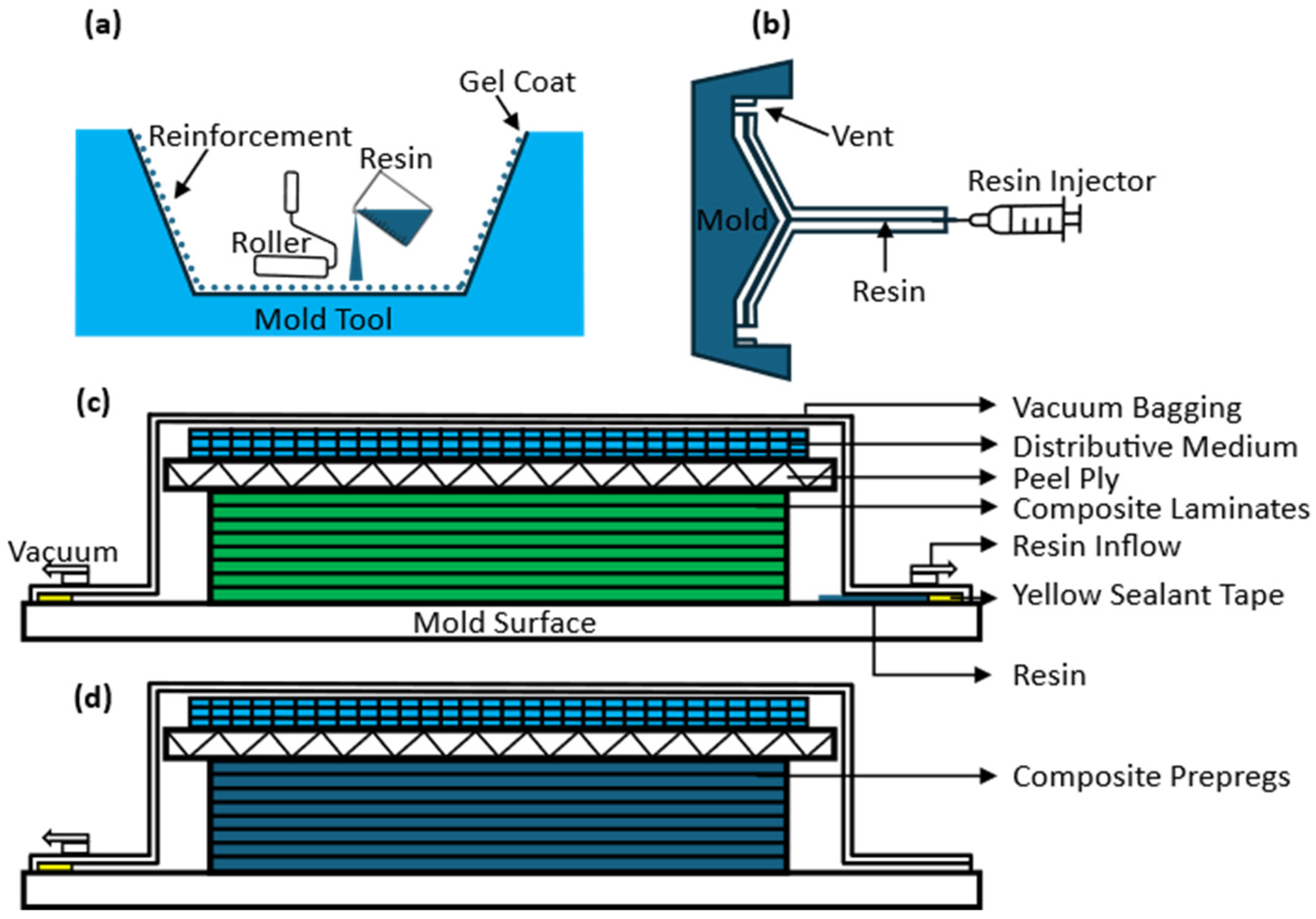
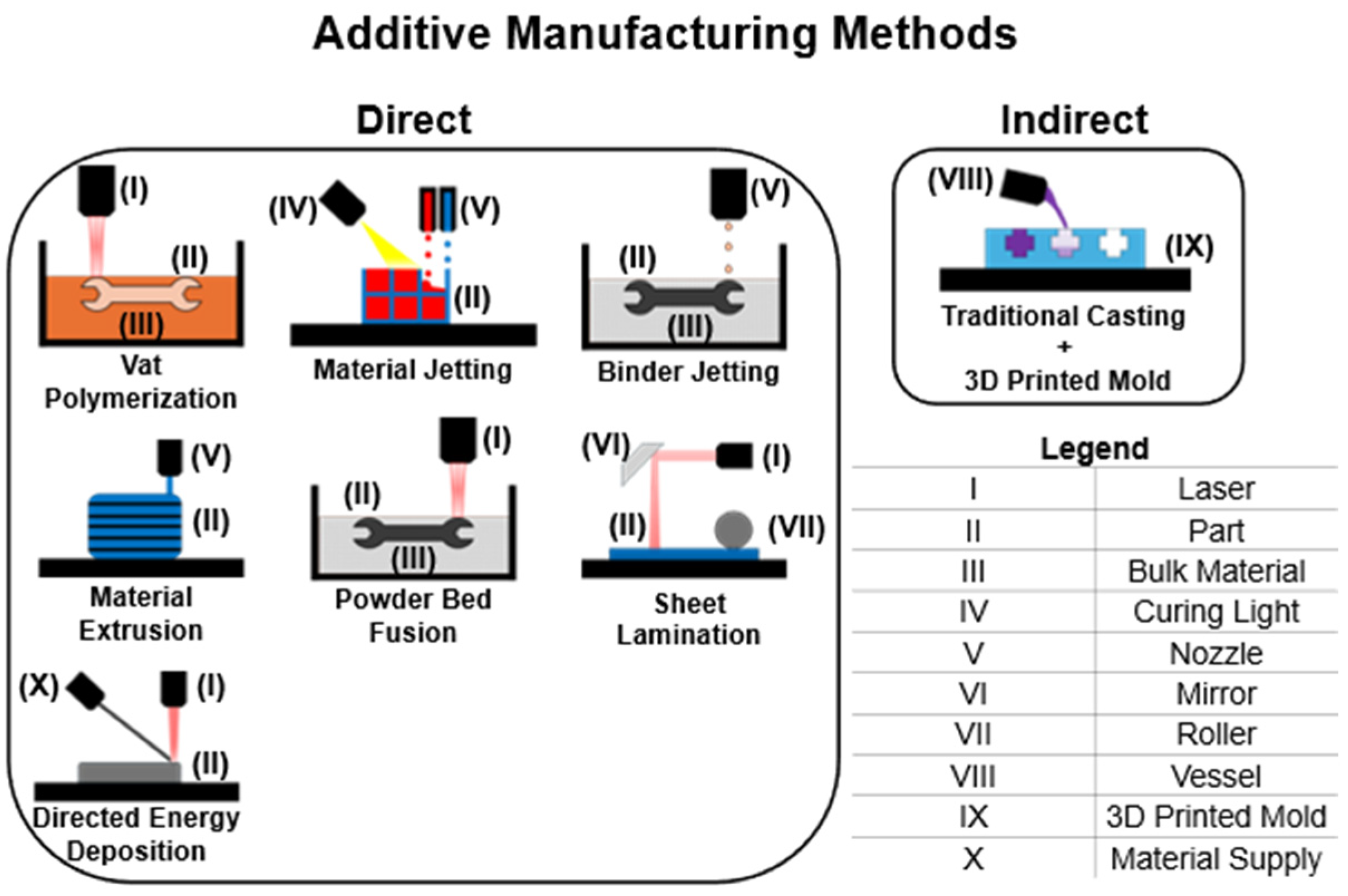

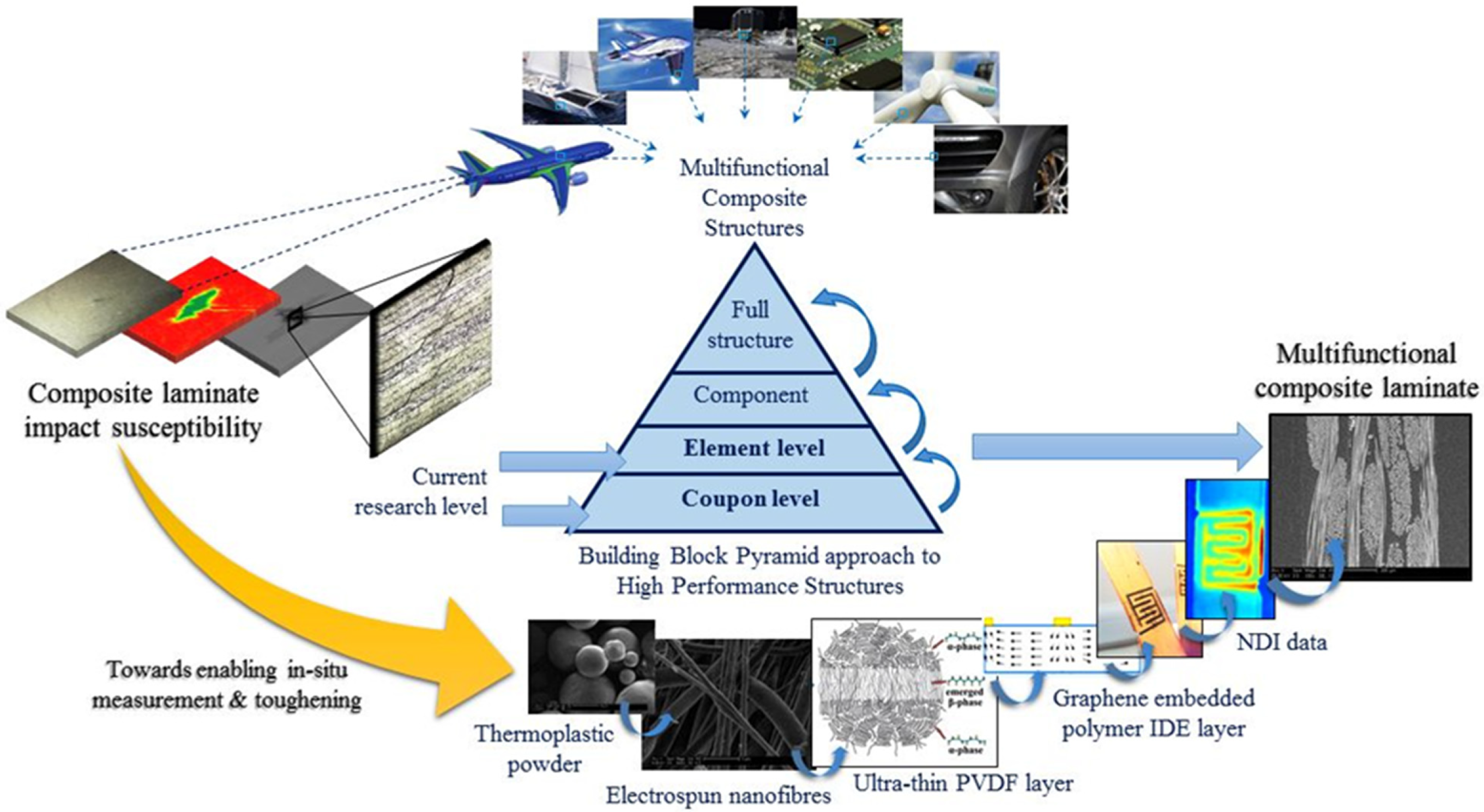
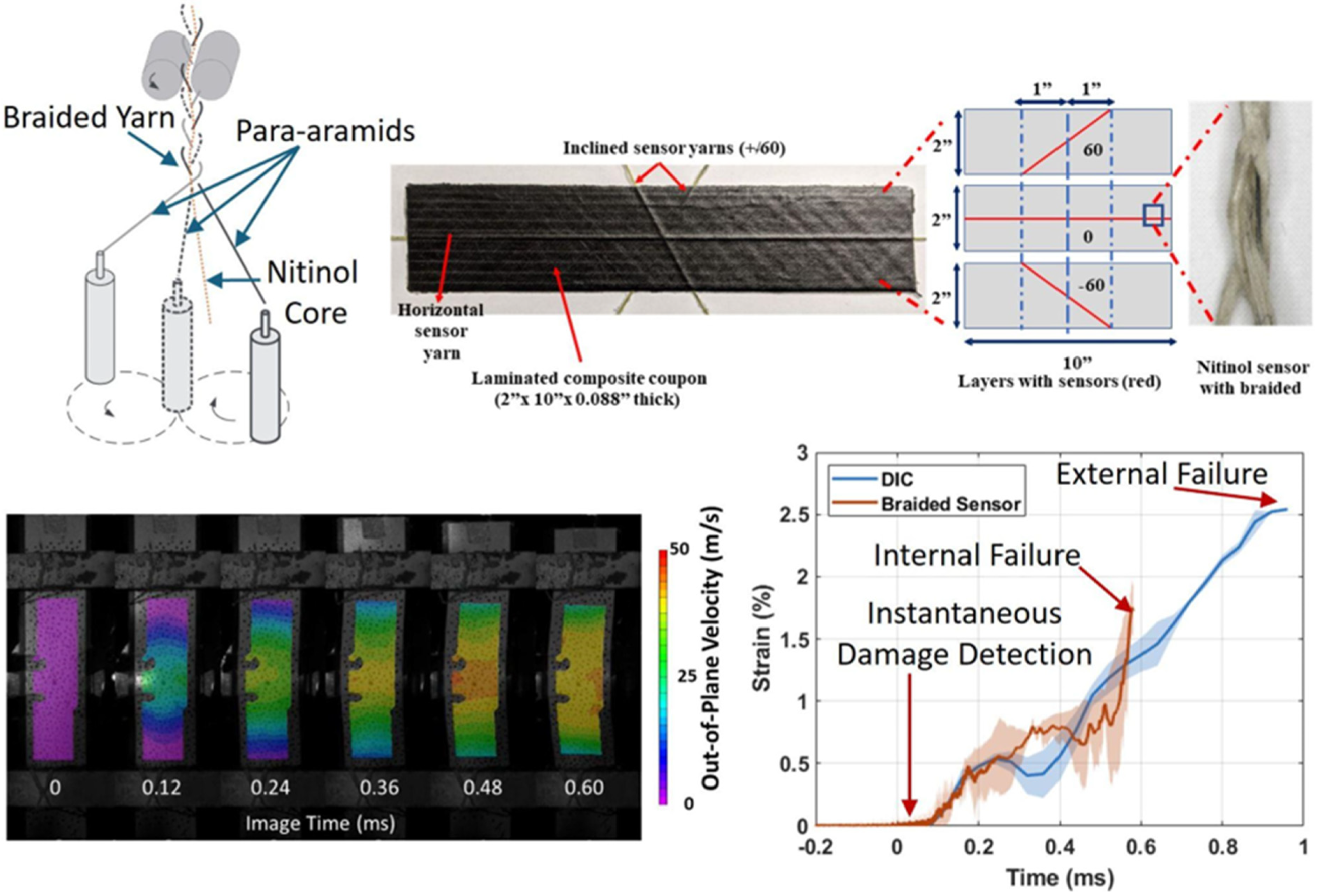
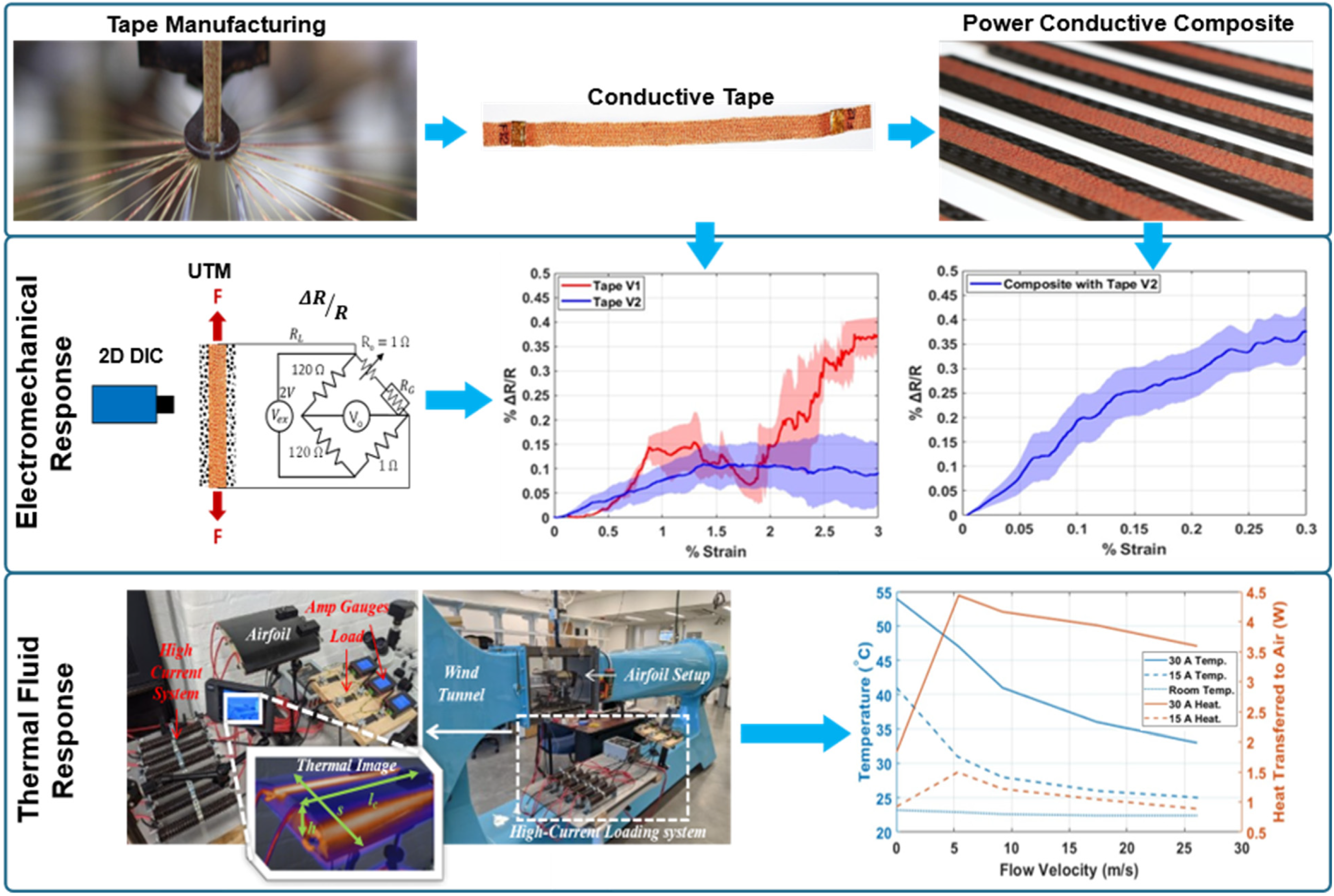
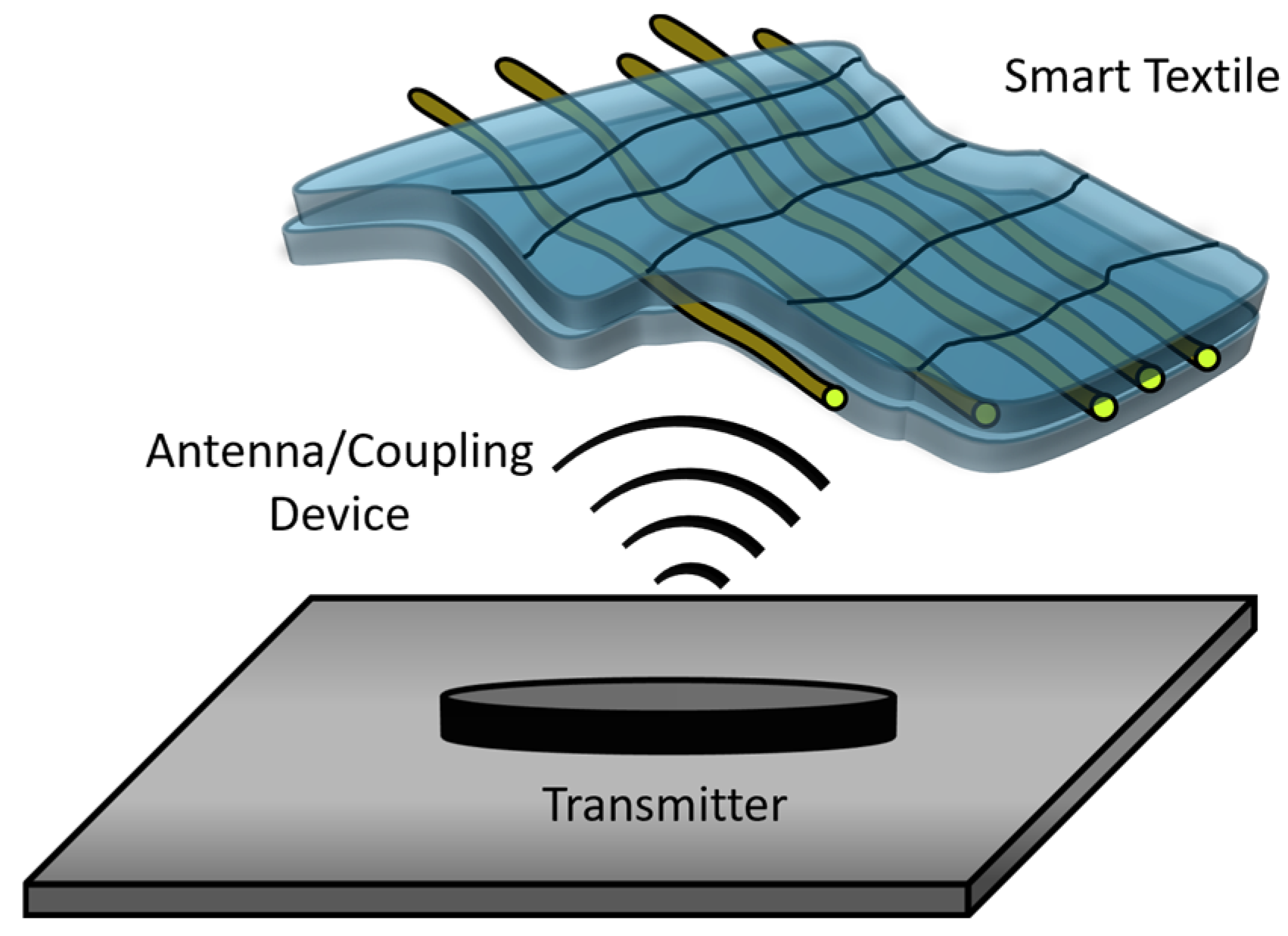
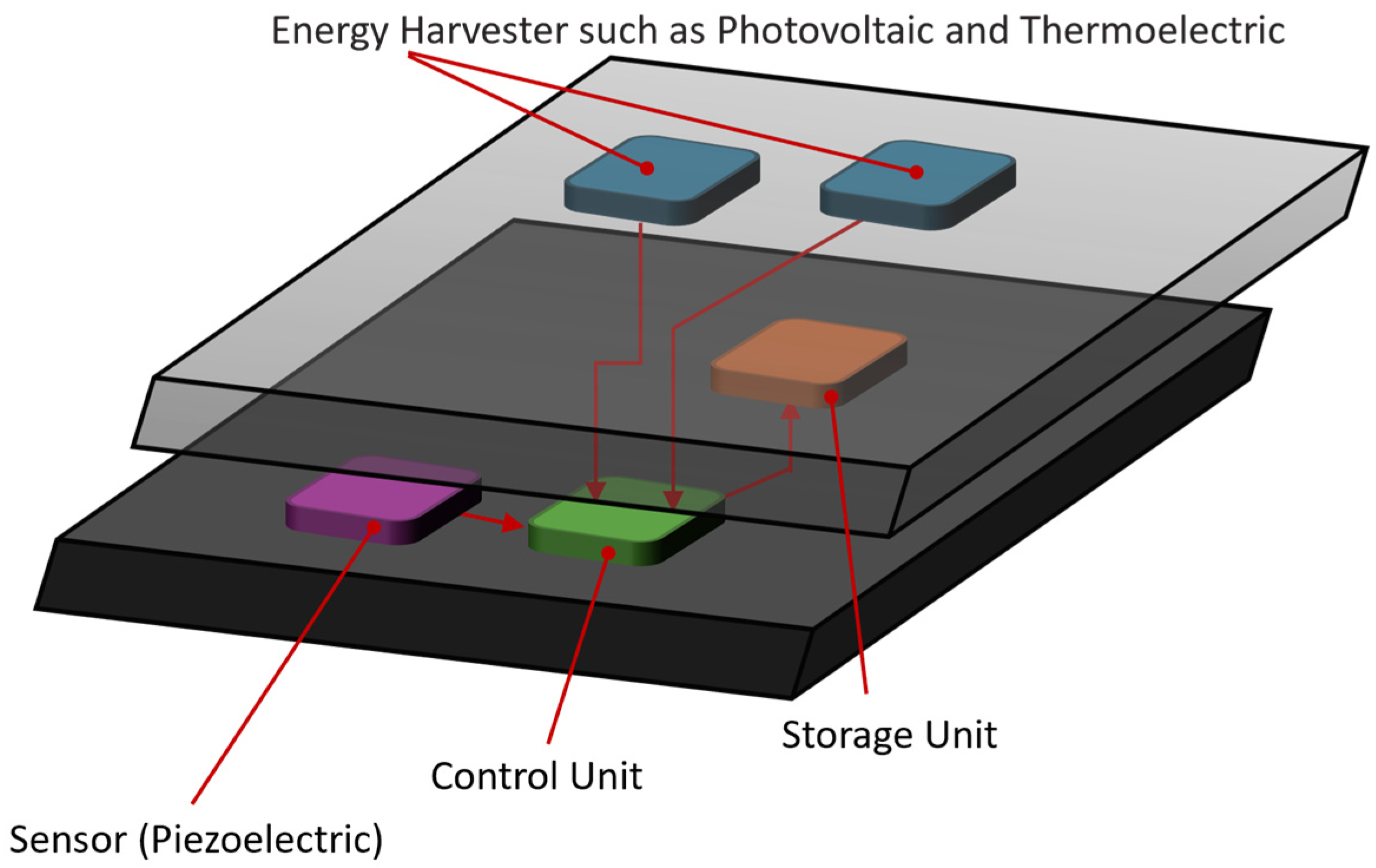
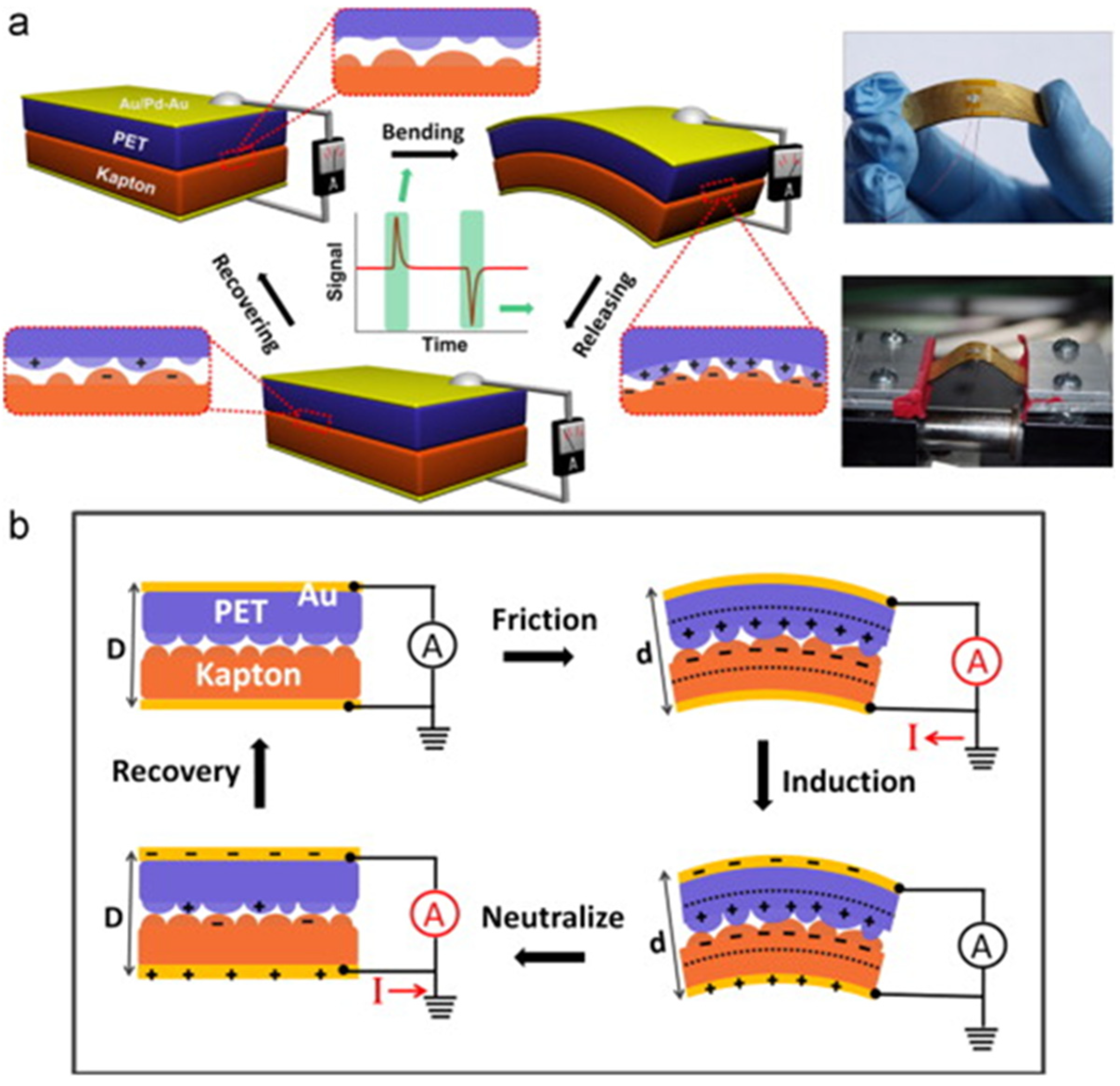
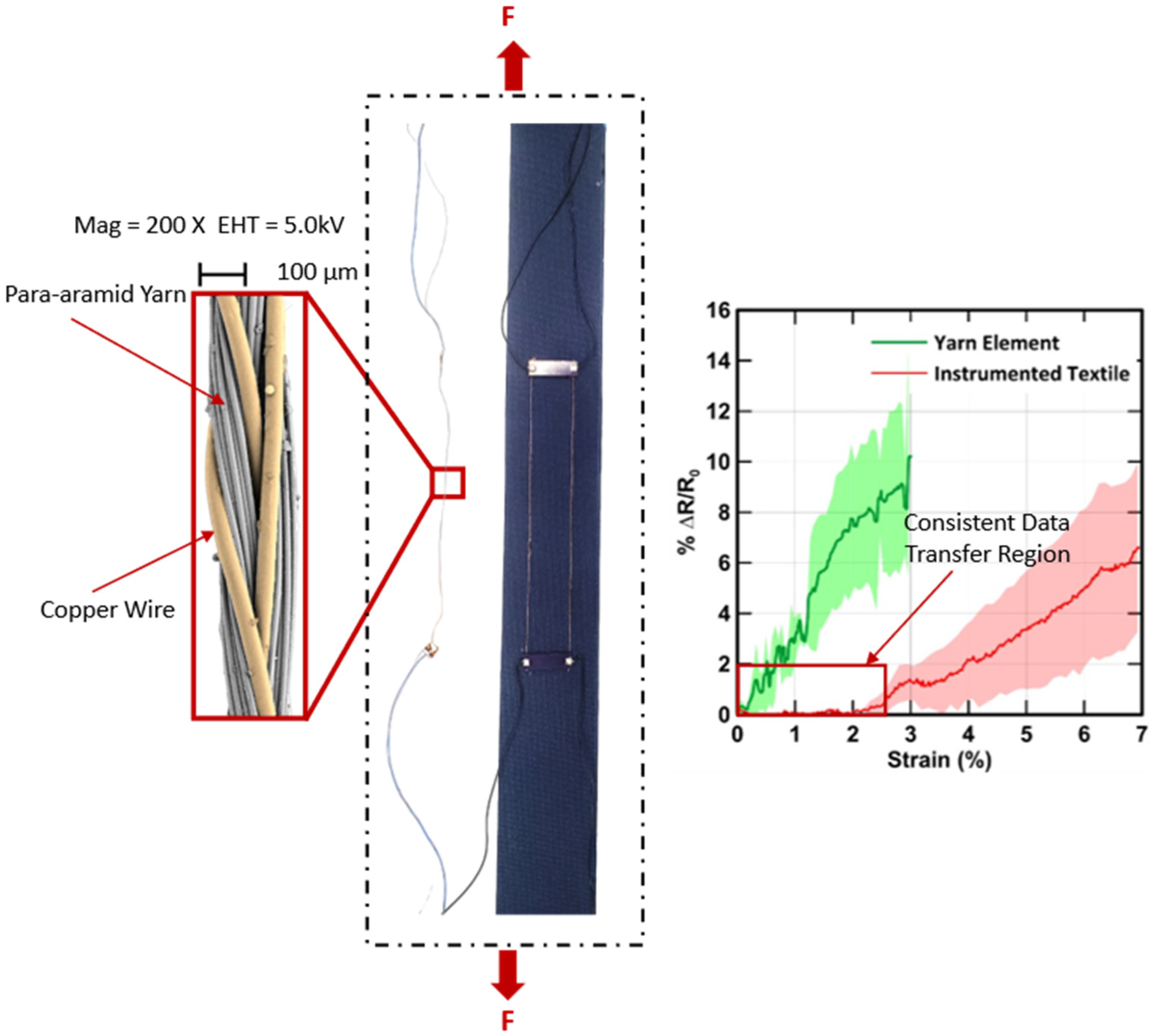
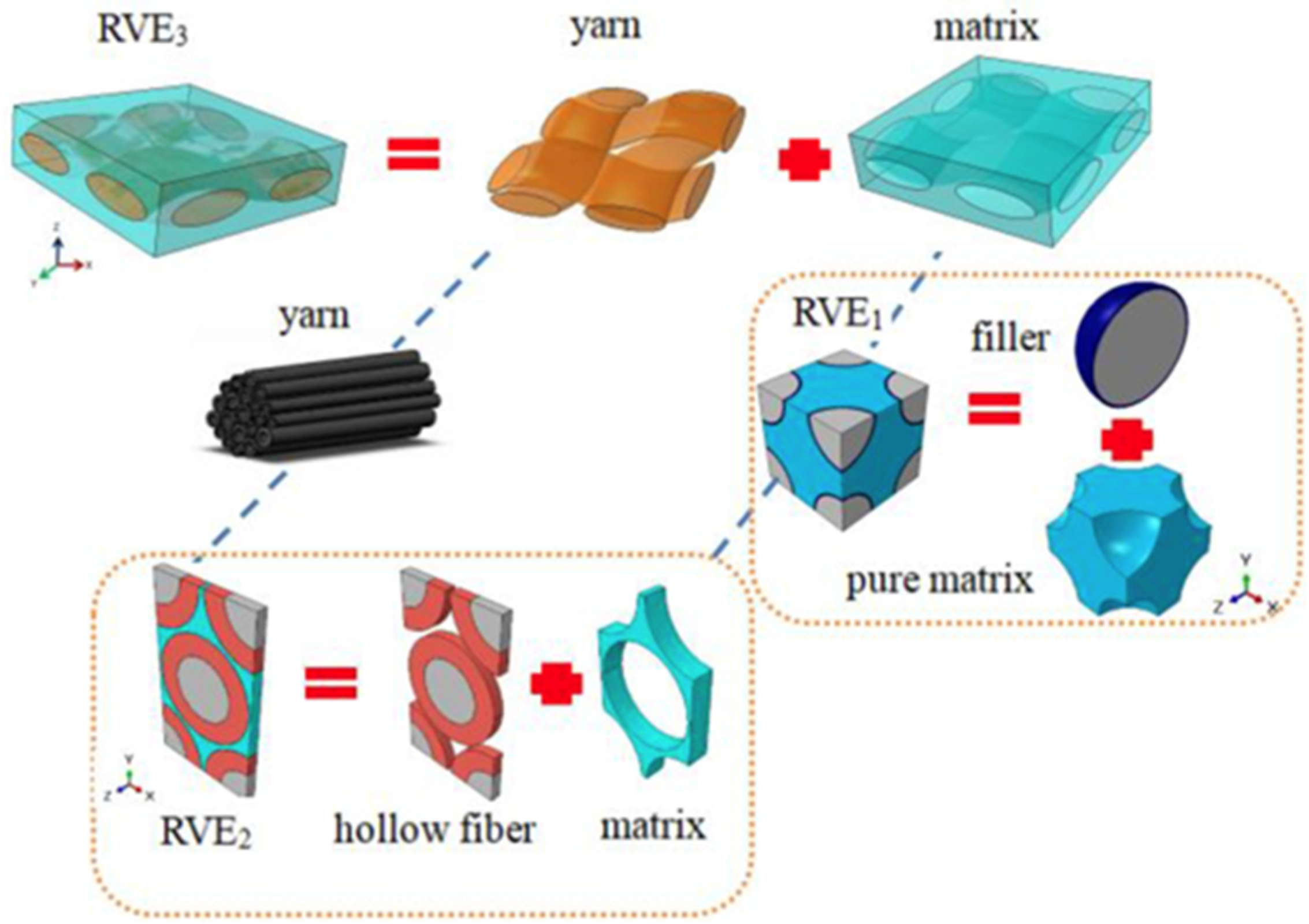

Disclaimer/Publisher’s Note: The statements, opinions and data contained in all publications are solely those of the individual author(s) and contributor(s) and not of MDPI and/or the editor(s). MDPI and/or the editor(s) disclaim responsibility for any injury to people or property resulting from any ideas, methods, instructions or products referred to in the content. |
© 2024 by the authors. Licensee MDPI, Basel, Switzerland. This article is an open access article distributed under the terms and conditions of the Creative Commons Attribution (CC BY) license (https://creativecommons.org/licenses/by/4.0/).
Share and Cite
Chaudhary, B.; Winnard, T.; Oladipo, B.; Das, S.; Matos, H. Review of Fiber-Reinforced Composite Structures with Multifunctional Capabilities through Smart Textiles. Textiles 2024, 4, 391-416. https://doi.org/10.3390/textiles4030023
Chaudhary B, Winnard T, Oladipo B, Das S, Matos H. Review of Fiber-Reinforced Composite Structures with Multifunctional Capabilities through Smart Textiles. Textiles. 2024; 4(3):391-416. https://doi.org/10.3390/textiles4030023
Chicago/Turabian StyleChaudhary, Birendra, Thomas Winnard, Bolaji Oladipo, Sumanta Das, and Helio Matos. 2024. "Review of Fiber-Reinforced Composite Structures with Multifunctional Capabilities through Smart Textiles" Textiles 4, no. 3: 391-416. https://doi.org/10.3390/textiles4030023
APA StyleChaudhary, B., Winnard, T., Oladipo, B., Das, S., & Matos, H. (2024). Review of Fiber-Reinforced Composite Structures with Multifunctional Capabilities through Smart Textiles. Textiles, 4(3), 391-416. https://doi.org/10.3390/textiles4030023







